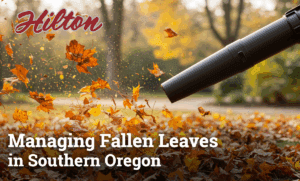In late autumn, many homeowners in Southern Oregon face the same question: What should we do with all these fallen leaves? Should we leave them where they lie, rake them up, toss them in the refuse bin, compost them, or even burn them? At Hilton Landscape Supply, we believe the best approach is a thoughtful, context-sensitive plan for managing fallen leaves—one that balances aesthetics, soil health, wildfire safety, and biodiversity.
 Rethinking the Rake
Rethinking the Rake
Leaving some leaf litter in place can be beneficial. Fallen leaves act as a natural mulch, decomposing slowly and releasing nutrients back into the soil. They protect the soil surface from drying winds, reduce runoff, and help buffer temperature extremes. Over time, those nutrients strengthen root systems and improve soil structure.
Leaves also support wildlife and ecosystem processes. A modest layer of leaf litter provides habitat and shelter for insects, worms, amphibians, fungi, and microorganisms. Those creatures, in turn, support birds and healthy soils. And, of course, leaving a sensible amount of leaves saves time, labor, and disposal costs.
Why You Can’t Always Just Leave the Leaves
In Southern Oregon—where wildfire risk is real—leaving leaves indiscriminately is not a free pass. Accumulated leaf litter, needles, and dead plant material represent fuel, especially during our dry, windy periods. Within the first 30 feet around your home and outbuildings, it’s important to keep areas lean, clean, and green by removing fine, dry debris.
Thick mats of unshredded leaves on lawns can smother grass by blocking sunlight and air exchange. Turf declines, thin spots develop, and weeds move in. Leaves piled in gutters or against foundations can also create drainage and moisture problems. Finally, burning yard debris is risky and, at times, prohibited. Even when allowed, it demands careful conditions and oversight; one stray ember can cause devastating losses. When in doubt, choose safer options.
A Hybrid, Zone-Based Strategy
At Hilton Landscape Supply, we recommend a tiered approach to managing fallen leaves—different tactics depending on location, function, and fire risk.
- Critical zones around structures: rake and clear
Remove accumulated leaves, especially dry, loose litter, within roughly 30 feet of your home, garage, or other buildings. Keep gutters, eaves, decks, and roof valleys free of debris. This creates a defensible space that helps protect your home during wildfire season. - Lawns and turf: mow or lightly rake (or shred in place)
On grassy areas, avoid letting thick layers build up. Use a mulching mower to shred leaves and disperse them evenly—small pieces decompose faster and enrich the soil. Alternatively, rake and relocate leaves to garden beds, compost piles, or a leaf-mold area. A light scattering of shredded leaves is fine if it doesn’t overwhelm the grass. - Garden beds and under shrubs: leave or mulch
In beds under trees, shrubs, or perennials, you can often leave leaves in place (ideally shredded) as natural mulch—provided they don’t form an impenetrable layer. Maintain a few inches of clear space around trunks and stems to discourage rot and pests. - Composting and leaf mold: put leaves to work
Leaves are a superb carbon source for composting. Shred or chop them to speed up breakdown, then mix with green materials like grass clippings and kitchen scraps. Or let a dedicated leaf pile age into leaf mold—a dark, crumbly amendment that boosts water retention and soil tilth. - Refuse or green-waste bin: use when needed
If you lack space or time for composting, bag excess leaves for curbside yard-debris pickup or take them to an approved green-waste facility. This keeps combustible material out of high-risk areas and prevents nuisance piles from accumulating.
Why This Balanced Method Works for Southern Oregon
Wildfire readiness: Our region’s climate and vegetation demand vigilance. Completely leaving every leaf in place can create fuel pathways, but clearing all debris sacrifices soil health and habitat. A zone-based strategy provides defensible space near structures while allowing beneficial leaf retention where it’s safe.
Soil and plant health: By mowing, shredding, or composting as needed, you prevent turf smothering and promote steady nutrient cycling. Rather than importing synthetic inputs, you’re returning organic matter that improves structure, moisture management, and resilience.
Wildlife and biodiversity: Thoughtful retention of leaf litter supports insects, beneficial fungi, and the broader food web. In a managed landscape, those ecological services translate into healthier plants with fewer interventions.
Practical and aesthetic benefits: Pathways, patios, and gutters stay clear and safe. Beds look tidy with a purposeful mulch layer. Lawns stay vibrant. You get the beauty of fall without the headaches of soggy mats and clogged drains.
Hilton Landscape Supply Helps You Maintain Healthy Landscaping
Managing fallen leaves is not a one-size-fits-all proposition. In Southern Oregon, we must balance soil health, aesthetic goals, wildlife needs, and wildfire safety. Our recommendation: leave leaves where they do the most good, and remove them where they pose a risk. Shred and mulch when you can, compost what you have room for, and use green-waste services when necessary. Avoid burning whenever possible.
For expert advice, products, and practical solutions, visit Hilton Landscape Supply online or stop by in person. Our team is ready to help you with managing fallen leaves and all the supplies you need for a healthy yard and garden.

 Rethinking the Rake
Rethinking the Rake